
“E-cigs can kill!” yells the Sun, “Just ONE puff of flavoured e-cigarette vapour ‘contains dangerous levels of cancer-causing chemicals.’”
Stories like this have been all over the news for the past week, undoubtedly adding to the uncertainty many smokers have about the risks of e-cigarettes. The chemicals in question are aldehydes, and formaldehyde is both the most well-known example and the one that’s been most closely tied to vaping. The issue has been aired out many times before, with studies finding high levels of formaldehyde but only in very specific circumstances that don’t represent how vapers vape in the real world. The newest study claims to avoid this trap, but whether they really did is questionable, and before jumping to conclusions, it’s best to consider all of the data rather than just one study.
The big question is whether you should be worried about formaldehyde in e-cigarettes overall. Does it mean that e-cigs aren’t as safe as they claim to be? Does it mean e-cigs will give you cancer? Is the Sun right that vaping can kill?
Here’s what you need to know.
Contents
- Summary
- What is formaldehyde?
- Formaldehyde and cancer
- Formaldehyde in e-cigarettes: Where does it come from?
- The importance of dry puffs for formaldehyde and e-cigarettes
- The evidence on e-cigs and formaldehyde so far
- The new study – Formaldehyde and flavorings
- Formaldehyde in cigarettes vs. e-cigarettes
- Should vapers be worried about formaldehyde
- How to avoid formaldehyde in e-cigarettes
- Formaldehyde and vaping: Don't panic!
Summary:
- Formaldehyde is a common organic chemical, found in everything from plywood to pears, and it’s naturally produced in your body.
- It’s been linked to a few cancers, but in general the evidence is spotty and inconsistent. However, several groups (for example, the IARC and the U.S. EPA) have listed it as a probable or known carcinogen.
- Formaldehyde in e-cigarettes comes from PG and VG thermally degrading, and PG seems to be the main culprit. A new study presents evidence that some formaldehyde comes from flavorings.
- Dry puffs play a central role in discussions of formaldehyde and e-cigarettes. This is where there isn’t enough liquid in the wick and the juice that is there gets “overcooked,” so to speak. This tastes horrible and is always avoided.
- Overall, most tests show less than 1 µg of formaldehyde per puff, and sometimes much less. However, studies affected by dry puffs show much higher levels. Atomizers with better wicking tend to have lower levels.
- The new study found very high levels of formaldehyde, with one device in particular putting out over 40 µg per puff on most juices, but oddly found none in the tests of unflavored liquids.
- The results don’t appear to be due to dry puffs, though the method used by the authors doesn’t seem to protect against them well.
- Dr. Farsalinos is attempting to replicate the new study, to see if the finding is valid or identify the cause of the discrepancy. In any case, all we can do is consider all of the evidence rather than trusting this one result over all others.
- Smokers inhale substantially more formaldehyde than vapers based on the average results of most studies.
- Although workplace guidelines weren’t intended for a vaping-like exposure, they don’t suggest a cause for concern based on most studies of e-cigs and formaldehyde.
What is Formaldehyde?
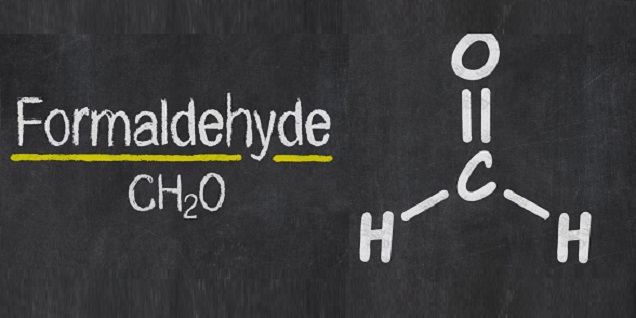
First things first, what is it that everybody is worried about? Formaldehyde is all around is, in things like plywood, glues and adhesives, some fabrics, some fruits (like pears), and it’s even produced naturally by most living things. It's the simplest “aldehyde” chemical, with the formula CH(2)O. If you’re exposed to a significant amount of it (over 0.1 part per million), you might experience symptoms like a burning sensation in your airways and eyes, coughing and skin irritation.
Formaldehyde and Cancer
The link between formaldehyde and cancer has been supported by the International Agency for Research on Cancer (IARC), the U.S. Environmental Protection Agency (EPA) and the National Toxicology Program (NTP). The evidence is fully summarized in the IARC’s monograph on the topic, if you’re interested. Alternatively, this page has an easier-to-read summary of the data, but not as much detail.
One thing that’s worth mentioning is that the link between formaldehyde and cancer isn’t as robust as you may think. There are issues with some of the studies finding a link with nasopharyngeal cancer. For example, one plant showed apparently anomalous results and was largely responsible for the conclusion of one of the most influential studies. Some meta-analyses and reviews of the evidence have also concluded that the evidence of a link in humans is unconvincing.
Similarly, while some studies showed a link between formaldehyde and leukemia, others fail to find a link. There was also some concern about formaldehyde and lung cancer, but this concern hasn’t been backed up by data and the original cases were probably due to other factors.
This is obviously a complex issue, and one I’m ill-equipped to deal with in detail, but the key point is that the link between formaldehyde and cancer likely isn’t as strong as you may believe it to be. In fact, even the infamous New England Journal of Medicine formaldehyde study on e-cigs estimated the risk of cancer attributable to formaldehyde for a pack a day smoker to be a little under one in a thousand.
Formaldehyde in E-Cigarettes: Where Does it Come From?
Formaldehyde has been detected in e-cig vapor (more on that soon), and it appears that the propylene glycol is a major source of it. This is nicely explained (in detail) in response to a question on Stack Exchange, but the short version is that PG can degrade into formaldehyde as part of an incomplete combustion reaction. It’s thermal (heat-related) degradation, so the temperatures involved are central to the amount of formaldehyde that comes from PG. VG can degrade into acrolein too, in a similar way.
The role of PG in particular has been supported by research. For example, one study (which we’ll discuss in more detail soon) looked at a PG-based liquid, a VG-based liquid and a PG/VG mix at different voltages to see how much they gave off aldehydes. The results showed that only the PG-containing ones produced a lot of formaldehyde, with the PG/VG mix producing the most. The VG-based e-liquid barely gave off any formaldehyde.
As a side note, some vapers I’ve seen in comment sections are under the impression that burning cotton is what generates the formaldehyde, but this appears to be due to some confusion about the specific factor that occurs during a dry puff which is responsible. While there will (or at least could be) burning cotton during a dry puff, the big issue is the temperature the liquid reaches.
With less liquid in the wick, there is less stuff there to absorb the heat energy given off by the coil, so the temperature increases instead. This temperature drives the reactions in the PG and VG that are still in the wick. It’s clearly not to do with cotton because the most famous study detecting formaldehyde didn’t even use a device with a cotton wick. That said, though, burning cotton tastes nasty too and is still not a good thing to be inhaling.
The new study on formaldehyde in e-cigs also points out that some of the formaldehyde (and similar chemicals like acetaldehyde) may come from the flavorings used in e-juice. Many common flavorings are based around aldehydes, and the authors describe how some of these can react and become formaldehyde during vaping. The results of the new study appear to support this quite strongly: the quantity of formaldehyde given off during vaping decreased when an e-juice with flavoring was diluted with PG and VG.
The Importance of Dry Puffs for Formaldehyde and E-Cigs
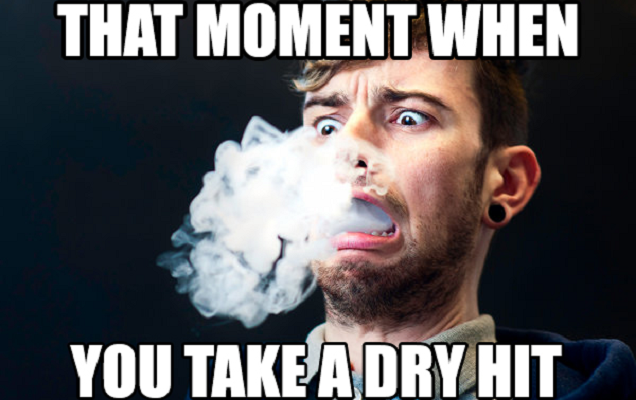
The crucial factor in most discussions of formaldehyde in e-cigs is the “dry puff” phenomenon. As the name suggests, this is when there isn’t enough liquid in the wick but you try to vape. To understand this, we’ll first consider what happens during ordinary vaping.
When your wick has plenty of liquid and you activate the coil, the resistance of the coil turns some of the energy flowing through it into heat, and this heat is emitted by the coil. The liquid in your wick absorbs this energy, and this is what vaporizes it. The process of vaporizing the e-liquid requires heat, and this is what keeps the temperature low.
So what happens when there isn’t enough liquid in the wick? The heat is still generated, but there is much less liquid there to be vaporized and keep the temperature down. This means the wick and coil gets hotter, and this additional heat “overcooks” the PG and VG, giving them enough energy to undergo reactions and turn them into formaldehyde, acrolein and other chemicals, as described in the last section.
For a vaper, the most notable thing about a dry puff is that it tastes absolutely awful. The flavor from your e-juice seems to fade at first, but then the sensation becomes incredibly unpleasant. The issue isn’t so much the taste; it’s more the stinging, almost burning sensation when you inhale formaldehyde and similar chemicals. It’s incredibly unpleasant, and that’s why no vapers vape like this.
Although one of the most widely-known issues that cause dry puffs is your voltage or wattage setting being too high, it can arise in slightly different ways too. For example, if you puff too frequently, the wick might not have enough time to replenish itself, and this can cause the same issue. This is especially likely for a top-coil atomizer design. Having too little juice in your tank, or having juice that’s too viscous (i.e. a high-VG blend) can cause the same problem too.
It’s worth stressing that there is some formaldehyde in e-cig vapor whether or not it’s a dry puff situation. Dry puffs increase the quantity dramatically, but under normal circumstances there is still formaldehyde. Chemically, some of the molecules always have enough energy to undergo the reaction. Increasing the temperature just increases the average energy of the molecules and thereby makes the reaction happen more often.
The Evidence On E-Cigs and Formaldehyde So Far
So now we’ve covered why you might get dry puffs when you’re vaping, and why you can get some formaldehyde even in non-dry puff situations, it’s time to look at what the studies conducted so far have found.
Initial Findings on Formaldehyde
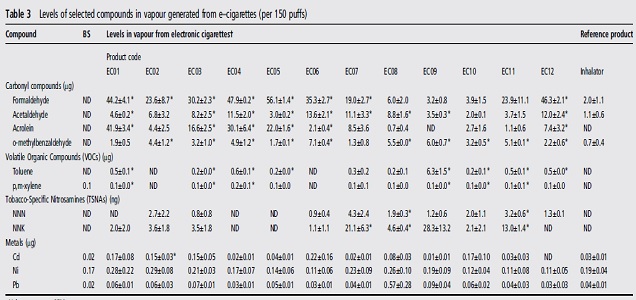
One of the first studies reporting formaldehyde levels in e-cigarettes was conducted in 2013, and generally found that levels of toxicants and carcinogens in e-cig vapor were 9 to 450 times lower than their levels in conventional cigarettes, if present at all. Although there was quite a lot of variation between different devices, levels of formaldehyde on average were 0.189 µg per puff. 1 µg is 0.001 mg, or 0.000001 g.
Many of the early studies with data on formaldehyde levels in e-cigarettes are summarized in Igor Burstyn’s review of the research on the chemistry of e-cig vapor. This study compares the results of studies to the workplace limits for exposure to these chemicals, and generally found that exposures from vaping are well within those limits, including for formaldehyde.
Dry Puffs and Science by Press Release – Formaldegeddon: Round One

The first study to really create a fuss about formaldehyde was published in 2014, and was reported in the New York Times before the study had been published by the journal. The researchers tested 10 commercially-available e-liquids and three “control” e-liquids at 3.4 V, and then conducted tests at 3.2, 4 and 4.8 V with the three control liquids. The results showed that the commercial e-liquids had about 0.0024 µg of formaldehyde per puff, if you count the results below the limit of quantification as the maximum they could be.
The high voltage tests are what really made the study take off, though. The control liquids tested at 3.2 V showed very little formaldehyde: 0.0013 µg per puff for the VG juice, 0.0087 µg per puff for PG and VG, and 0.035 µg per puff for the PG juice. When the researchers cranked the voltage up to 4.8 V, the situation looked a lot worse. For the VG juice, there was 0.01 µg of formaldehyde per puff, for the PG and VG juice there was 1.8 µg per puff, and for the PG-only e-juice there was 1.2 µg (though this last result varied a lot between tests).
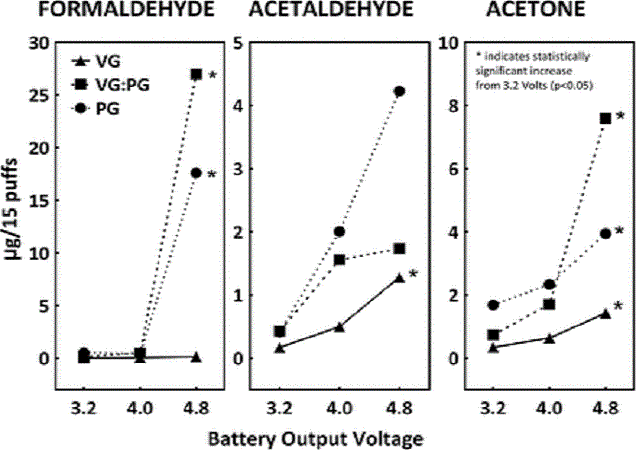
This was the first result that largely depended on the “dry puff” phenomenon. The study used a crappy top-coil clearomizer, and the highest voltage used was equivalent to vaping at 9.6 W, way higher than the atomizer could cope with. The huge (over 200-fold) increase when the voltage was increased shows the big difference dry puffs make to formaldehyde levels.
“E-Cigs Contain 10 Times More Carcinogens Than Cigarettes” – Formaldegeddon: Round Two
The next study to create concern about formaldehyde in e-cig vapor was a review of research conducted in Japan. The headline finding was e-cigarette vapor contains 10 times more “carcinogens” than cigarette smoke. The findings of the review didn’t support this conclusion. Firstly, what they mean by “carcinogens” is just formaldehyde, not the numerous other carcinogens found in cigarette smoke. Additionally, the evidence from the review shows that across brands, the average formaldehyde content was 0.42 µg per puff. Even the most formaldehyde-emitting brand still had 6 times less formaldehyde than found in cigarette smoke. The average amount detected was around 48 times lower than the levels in cigarette smoke.
The “10 times” more figure that made its way around the media was chased up by Dr. Farsalinos, who found that the result was actually an unpublished finding from a newer-generation, more powerful e-cig. As in the previous study, this result is likely due to dry puffs. Much worse, without publication we can’t see the method used, and this is only a single, cherry-picked result out of many. In other words, this effectively means nothing without further information.
The New England Journal of Dry Puffs – Formaldegeddon: Round Three
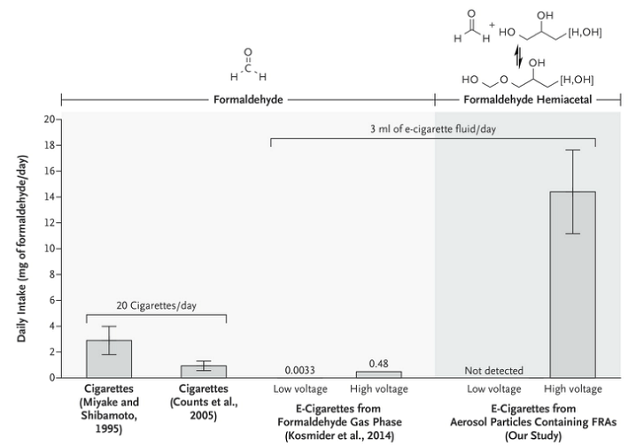
The most infamous study on formaldehyde in e-cigarette vapor was published in the New England Journal of Medicine, under the title “Hidden Formaldehyde in E-Cigarette Aerosols.” The result from this study was widely reported as being that e-cigarettes expose you to between 5 and 15 times more formaldehyde than smoking.
This study was widely misreported for more reasons than one. Firstly, the authors actually found formaldehyde hemiacetals (combinations of formaldehyde and PG or VG), and simply assumed (without evidence) that they carry equivalent risks to formaldehyde. In the low voltage (3.3 V) test, the authors didn’t detect any hemiacetals, but at the high voltage (5 V), they found 38 µg of formaldehyde hemiacetals per puff. Their estimates of formaldehyde exposure and the resulting risks were only based on the high voltage results.
The problem – yet again – was dry puffs. The researchers used a top-coil, CE4 clearomizer that simply can’t cope with the higher voltage used without dry puffs. After a reddit poster found out the resistance of the coil used, it became clear that the authors were vaping at 12 W, far beyond the tolerable range for real-world use of the CE4.
Dr. Konstantinos Farsalinos and Clive Bates attempted to inform the authors about this grave error, and pushed to have the study retracted. However, the authors showed little understanding of the issue (dismissing the criticism as “speculation”) and the study hasn’t been retracted.
What Happens When You Account for Dry Puffs?
The problems these studies suffer as a result of dry puffs was neatly demonstrated in a study by Dr. Farsalinos. The authors got seven vapers to identify settings that created dry puffs and then tested the aldehyde levels with that in mind. The authors used a customizable atomizer (a Kayfun Lite Plus), which was set up in two different ways: one had a dual-wick setup intended to reduce the risk of dry puffs and a single-wick setup which was more prone to dry puffs. They used an unflavored liquid for this test.
All of the vapers identified dry puffs at the same points (at 9 and 10 W). In non-dry-puff scenarios, the researchers found that while levels generally increased with power settings, the most formaldehyde per puff was 1.13 µg. In dry puff conditions, there was 11.9 µg of formaldehyde per puff at 9 W and 34.5 µg per puff at 10 W.
Their conclusion sums up the issue nicely:
Aldehyde emissions in [e-cigarette] aerosol are associated directly with dry puff conditions. In normal vaping conditions, the levels of aldehydes emissions are minimal and by far lower than the levels in tobacco cigarette smoke, despite the use of high power levels. In dry puff conditions, aldehyde emissions are significantly elevated to very high levels, but vapers are not expected to be exposed to such levels during normal [e-cigarette] use, even when they use new-generation high-power devices.
How Do Different Atomizers Affect Formaldehyde in E-Cigarettes?
For yet more sanity on this issue, another study looked at a wider range of atomizers and found that those with better wicking produced less formaldehyde, even if the wattage was increased. The least they found was 0.05 µg per puff and the most was 51 µg per puff, showing a massive variation depending on the power and atomizer combination.
The authors tested a CE4, a Protank, a Gladius, a Nautilus and a Subtank, using a 50/50 PG/VG e-liquid and various power settings. The CE4 and the Protank produced the most formaldehyde (up to 51 and 17 µg per puff at around 9 W, respectively), with all the other devices showing much lower levels. The Gladius put out a maximum of 0.59 µg per puff at 9.7 W, the Nautilus reached 0.21 µg per puff at 13 W (but it was actually 0.28 µg per puff at 9 W) and the Subtank only put out 0.34 µg per puff at 25 W.
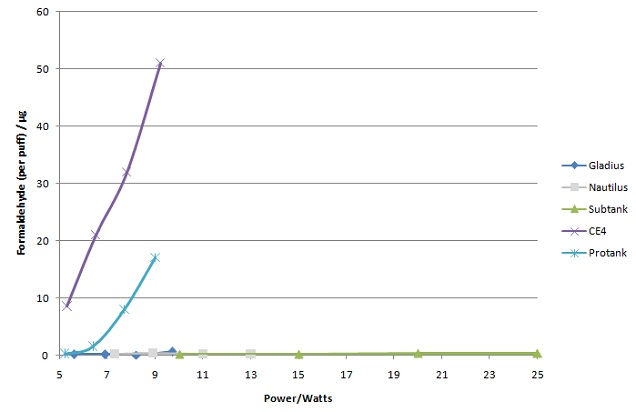
The conclusion from this is simple: atomizers with better wicking ability can cope with higher power settings without giving rise to dry puffs and high formaldehyde levels.
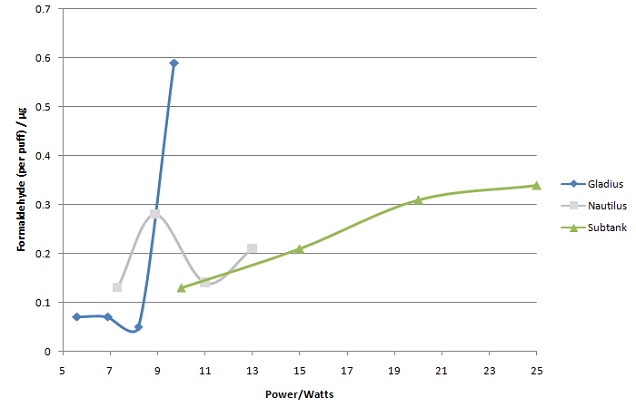
The New Study: Formaldehyde and Flavorings
Looking at the most relevant studies to the issue makes it pretty easy to understand what’s going on with formaldehyde in e-cigarettes. While small amounts of formaldehyde are common, large amounts have so far only been produced in dry puff conditions.
The new study on formaldehyde claims to change all of that, though. They found shockingly high formaldehyde levels, but claimed to have guarded against the issue of dry puffs. The devices they tested weren’t ideal, though. The Evod Glass was the most up to date device tested, with dual coil atomizer heads at a bottom-coil layout. This is basically like a ProTank or Aerotank as far as the coils are concerned. The others were a V2 cigalike and a top-coil CE4 (because they love CE4s). The Evod was vaped at 10.7 W, and the others were used at around 5 W.
The overall concept of the study was to look at the impact of flavorings on the amount of formaldehyde and other aldehydes given off by e-cigarettes. Flavoring chemicals can themselves be aldehydes, so it isn’t as weird an idea as it may sound.
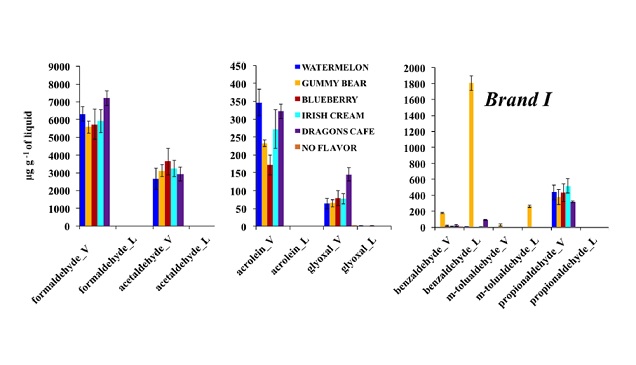
Overall, the researchers found pretty high formaldehyde levels. The results for the Evod in particular are shocking, though. The Gummy Bear flavor had the lowest formaldehyde emissions, but levels were still at a whopping 34.8 μg per puff, with others being over 40 µg/puff. Average levels were 43 µg/puff. This means two puffs would expose you to more formaldehyde than a whole cigarette.
However, all of the results for the cigalike were quite low – with an average of 0.79 µg/puff – and the values for the CE4 were lower than the Evod but still pretty high – an average of 10.5 µg/puff. For the Evod and the CE4, they had a flavorless e-juice to test, and all the aldehydes they tested for were either not present or only in very small quantities.
They illustrated the role of flavorings even more clearly by testing one that had been diluted to varying degrees before vaping. The results showed that the more the flavorings were diluted in PG and VG, the less aldehydes were released.
Were Dry Puffs to Blame for the Results?
Based on the history of studies on formaldehyde in e-cigarettes, the immediate assumption is simple: the only reason the authors got these results is that they used inappropriate settings and ended up with dry puffs. But is it true?
They did claim to have guarded against the possibility, but their methods don’t exactly inspire confidence. There are a few things in particular that would suggest dry puffs have a role to play, especially in the Evod results. Firstly, they used a 40 % VG e-juice, which shouldn’t cause much of an issue but does increase the juice’s viscosity in comparison to the others tested.
This is just the beginning, though. The researchers also tested the device horizontally (in line with the manufacturers’ recommendations) and only filled the tank 2/3 of the way up. This raises the distinct possibility that some of the wick wasn’t in direct contact with e-juice, which would increasingly present an issue as the test went on.
The researchers didn’t do everything wrong. They’ve clearly learned that high power settings can cause dry puffs, and opted to test the device at 4 V rather than 4.8 V. They also they followed recommendations from Dr. Farsalinos’ study of vaping patterns and used four second puffs with a 30 second interval between them (though they didn’t reference it). They say this is representative of real-world use, and offer two citations to that effect. One of these led to a diacetyl study that doesn’t really have much justification, but the other leads to the “One million puffs” study, which uses data from a smart e-cig to describe vaping habits. This citation seems to have been utterly ignored by the authors.
On the basis of a different study, they decided to use a 15 puff “warm up” period before sampling just two puffs after that. The only problem is that if they’d taken a look at the “one million puffs” study, they’d have found that the average length of a “series” of puffs taken by a vaper is between six and seven. In other words, their own references contradict the idea that sampling the 16th and 17th puffs is representative of real-world vaping.
Their reasoning is that the study showed that emissions reach a steady-state after around this point, but gradually increase up to then. However, put in another way, this means that they chose the method likely to give higher results rather than the one that’s more representative of how vapers vape in the real world. Unless reading the (very short) million puffs study was just too much hassle, it’s hard to see how they can assume this method is justified given the data they cited.
So putting it all together: these are the results obtained from using a slightly uncomfortably high power on a now-outdated atomizer, with the tank only two-thirds full, turned horizontal throughout testing and helped to approach “dry puff” conditions by an unjustifiable 15-puff warm up period prior to sampling.
However, Dr. Farsalinos has rightly pointed out a big problem with blaming dry puffs: the unflavored e-liquids didn’t show similar results, so that doesn’t seem to explain it. In fact, on the Evod test, the vast majority of aldehydes weren’t even detected for the unflavored juice.
Interestingly, about twice as much of the unflavored liquid was vaped per puff (compared to flavored blends), which seems to hint at wicking issues, but it isn’t really clear why flavorings would make such a huge difference. Personally I think this discrepancy must be relevant to what’s going on here. Why was the wicking or the vaping process so much more efficient on the anomalous, formaldehyde-free unflavored results?
If the setup was the same, I find it hard to believe flavorings had this much of an impact on the juice consumed per puff unless there was a lot of them. Dr. Farsalinos hasn’t (yet) received a response to his request for the name of the brand, so it could be that the authors have something to hide.
Speculation aside, the upshot is that while dry puffs are certainly a possibility, there are big problems with just putting the results down to dry puffs. We’ll have to wait to see what Dr. Farsalinos comes up with on his replication study to really get to the bottom of it.
Formaldehyde in Cigarettes vs. E-Cigarettes
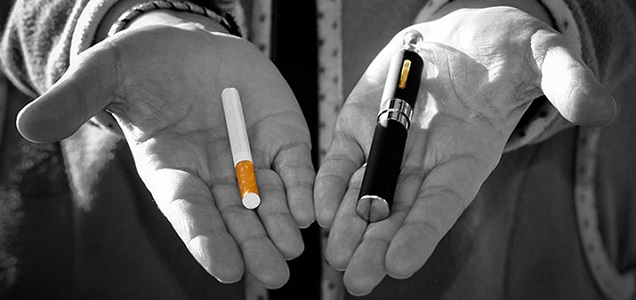
The big issue is whether vapers should be worried about formaldehyde. With several high-profile results over the past few years, and the recent study showing very high levels, concern is completely understandable.
The short version is that if you’d otherwise be smoking cigarettes, you shouldn’t be concerned. Even if e-cigarettes had more formaldehyde than traditional cigarettes, you’d still be avoiding very harmful chemicals like carbon monoxide by switching to vaping. However, with studies showing between 1 and over 200 µg of formaldehyde in the mainsteam smoke (the inhaled and exhaled part) from one cigarette, context is everything. Most commercial cigarettes these days release less than 60 µg of formaldehyde in their mainstream smoke.
While the new study would suggest that this is a concern, most underline the massive difference in formaldehyde exposure between smokers and vapers. In the study looking at multiple atomizers, for instance, the Subtank was found to put out 0.34 µg per puff. To reach the formaldehyde exposure from a single cigarette, you’d need to take 176 puffs. If you were vaping at the setting that produced the most formaldehyde (not counting dry puffs) from Dr. Farsalinos’ study, you’d need to take about 53 puffs to consume the formaldehyde from one cigarette.
When you compare the formaldehyde content of cigarette smoke with the amounts in vapor based on most of the studies conducted, smoking is clearly the bigger exposure. Dry puff scenarios are so unrealistic it isn’t even worth considering them. The new study would join these results as being concerning, but since they found such an unusual amount of formaldehyde; the results should be taken with a pinch of salt until they’re replicated by other researchers. Tests of other flavored e-liquids have found vastly lower levels, and the results even exceed most obtained in dry puff scenarios.
Should Vapers Be Worried About Formaldehyde?

As Igor Burstyn did in his review, the authors of the new study compare their results with workplace limits, and conclude that vapers exceed recommendations for formaldehyde by over 200 times. This is in stark contrast with Burstyn’s conclusion that vapers only consume about 3 % of the limit per day.
The reason for this discrepancy seems to be that the authors of the new study used the “instantaneous” limit whereas Burstyn used the average over a working day. The limits are expressed as concentrations in the air (in mg/cubic meter), so the researchers have to convert the vaping results appropriately. Burstyn used the amount given off by eight hours’ worth of vaping diluted into the total air you inhale during that time. The authors of the new study, though, worked out the concentration based on a single puff and one breath’s worth of air.
There are also different guidelines for workplaces, so it really depends a bit on what you look at. Using the OSHA’s permissible exposure limit (PEL), which is 0.75 ppm (or about 0.92 mg/cubic meter), you could inhale about 3 mg of formaldehyde per day and still be within the guidelines (assuming you inhale about 3.6 cubic meters of air in eight hours). At 300 puffs per day, this puts a limit at about 10 µg per puff.
Using the authors’ chosen limit (but averaged over the course of a day), you could inhale about 1.3 mg per day and still be within the recommendations. That would suggest a limit of about 4 µg per puff.
In any case, the evidence above shows that vapers are probably well within limits. The only question is how appropriate applying these limits to vaping is. This is an area of some debate, but on the positive side, they do offer some guidance as to what can be considered low-risk and what we should be worried about. Additionally, as Burstyn argues, vaping is voluntary exposure, so these limits are probably a bit too stringent. We regularly inhale over the recommended exposure to nicotine in the workplace, for instance, because we choose to.
On the negative side, though, they are designed for a different situation. Workers are only exposed eight hours per day, and aren’t exposed at the weekend. Additionally, vaping isn’t your only formaldehyde exposure, so calculations like those above probably understate the risk a little bit.
The upshot is that in an ideal world, we'd be able to vape without being exposed to any formaldehyde, but we can't. The bad news is that means that vaping can't be considered completely safe. However, the good news is that on the basis of established guidelines and the evidence we have so far, you probably aren't going to get cancer from the formaldehyde in vapor. We won't know for sure until we have long-term studies of vapers, but as Public Health England pointed out in their report (page 78), there is no evidence that the amount of formaldehyde vapers are exposed to poses a health risk.
How to Avoid Formaldehyde in E-Cigarettes
As we’ve stressed a few times, you can’t really avoid formaldehyde in e-cigarettes. There is always some, even outside of dry puff situations. However, the amount in these situations is generally low, and you’ll naturally avoid dry puffs anyway. The best advice if you’re really concerned is to get a temperature controlled e-cig, which allows you to completely avoid dry puffs by limiting how hot the coil can get. Although this hasn’t been directly tested (as far as I know), this will almost certainly keep formaldehyde levels low.
Formaldehyde and Vaping: Don’t Panic!
The recent study has kicked up a lot of familiar fuss for vaping, but a look at the evidence on the topic so far makes the unusual nature of the finding clear. It might not be too easy to dismiss the results as due to dry puffs, but when you look at it in comparison to all of the evidence, for whatever reason, it’s completely out of step with what we know so far. Without further confirmation from future studies, the evidence on formaldehyde in e-cigarettes suggests little cause for concern, especially if you’d be smoking otherwise.
So no, the Sun, the new study really doesn’t mean that “vaping can kill,” and reporting as if it does serves only to scare smokers away from making a positive decision for their health.

